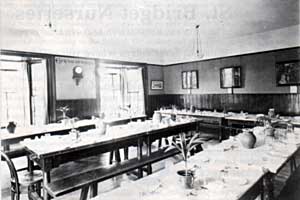
Mount Radford School
Page updated 11th January 2010
Mount Radford School was a well known private school during the last century. It was commonly known as ‘Vines School’ as the Vine's provided no less than three of the school’s four headmasters.
The name Mount Radford dates from 1570 when Lawrence Radford, an eminent lawyer, ‘did build him a fayre house and called it Mount Radford’. A century later the house was occupied by both Parliamentarian and Royalist forces during the Civil War.
The Baring family’s wool and serge business was based at Larkbeare and gradually John Baring had purchased most of the surrounding land. His estate included the Rectory and living of St Leonards. Baring’s sons extended their business to London and expanded into merchant banking where they were said to have funded the building of the British Empire. John Baring II later returned to Exeter and when his next door neighbour John Colesworthy suffered bankruptcy in 1755, bought his home, the ageing Mount Radford House and 17 acres of land for 2,000 guineas. He transformed the medieval house into a Georgian mansion approached by a drive’ lined with cedar trees, which ran from Magdalen Street and later became St Leonards road.
The house remained in the Baring family until 1826 when it became Mount Radford College, and remained so until 1902 when having closed it was demolished to make way for the development of Barnardo Road and Cedars Road.
The first Vine Mount Radford
Meanwhile in 1868 Mr E.H. Vine had opened a boarding school at Blandford in Dorset. Increasing numbers resulted in a move to Exeter, in 1875, where Mr Vine established his school at the Quadrant in Wonford Road where, it is believed, Charles Dickens’ younger brother was a pupil.
A second move took place in 1895 when the school was transferred around the corner to Park House ( built 1865) in St Leonards Road. The school premises stretched through to Roberts Road, and included several purpose built class room blocks, science laboratory, gymnasium, and a large playground. The rear entrance in Radford Road was on the site of a former tollgate.
The name Mount Radford School was adopted from the earlier establishment. The school crest and motto, ‘Spes Mea In Deo’ ( My Faith in God), were granted by special permission of Lady Radford.
Mr W.E. Vine, M.A., the eldest son of the founder, first joined his father at the school, at the age of 17, before going to the University College of Wales at Aberystwyth. He returned to the school and succeeded to the headmastership in 1901, and held office until 1916 when he was invited to become the director of the Missionary Society in Bath. He was followed by his younger brother, the much loved Theodore Ernest Vine who continued as head until his retirement in 1957. Another brother Edward Valentine Vine was one of 27 masters and boys who gave their lives for King and Country in the Great War.
The school generally averaged around 200 pupils, many boys came from farming and the local business community, and continued to take boarders, often the offspring of missionaries serving abroad, until the end of the Second World War. For much of his career as headmaster E.T Vine was assisted by two loyal lieutenants, Messrs S.B. Angwin and W.A.‘Buster’ Wheatley. Mr Wheatley, a retired Indian Army officer, organised sport which originally took place in a field off Burnthouse Lane but from 1929 at the School’s own sports ground bordering Salmon Pool Lane. The Field, as it was known, accommodated two football pitches, a cricket pitch and a 440 yard running track. The site was acquired by the courtesy of King’s College, Cambridge, who had owned the land since 1444 having been granted it by King Henry VI. Swimming took place in the Exe at Head Weir but later switched to the City Baths in Heavitree Road.
Tommy Cooper
The comedian, Tommy Cooper, attended Mount Radford in the thirties and is probably the most famous pupil. He was commemorated in 1993 by the Old Radfordians Association who commissioned a plaque which can be seen in the chapel at Bramdean School where the principal, Tony Connett, also attended Mount Radford School.
The Second World War saw another 25 Radfordians make the ultimate sacrifice. The youngest was 16 year old Tony Colquhoun, who was killed with his father by a bomb in Matford Lane.
Mr Vine retired in 1957 and the school was taken over by Mr A. Greenaway. An Army Cadet Unit was formed, and in 1960 pupils were able to go on regular continental holidays thanks to the enthusiasm of Mr Ken Bovey, who joined the staff in 1959.
The Salmon Pool Lane sports field was sold for building in 1963 and the school closed in 1967. The classrooms were demolished to make way for house building, and the roadway named ‘Vine Close’. Park House first became accommodation for students at St Lukes College, and is now a nursing home. The school war memorials were moved to St Leonards.
Old Radfordian Association
Happily the ethos of the School lives on through the Old Radfordian Association. The ORA was formed in 1929 and for many years the driving force was its secretary , later president, Mr Cyril Sole, who was both an old boy and a teacher. Forty years on from the closure of the School the ORA till attracts 60-70 members, some travelling from as far as Australia and the Middle East, to its annual reunion dinner each April. Among the regulars are three former teachers Ken Bovey (Minute Secretary), Joe Coop, and Mrs Barbara Howard, the very popular art mistress.
More on the Old Radfordians Association.
©2008 Tony Lethbridge
 Headmaster T E Vine 1916-1957.
Headmaster T E Vine 1916-1957.
 The Dining Hall.
The Dining Hall.
 The Dormitory - later Upper V.
The Dormitory - later Upper V.
│ Top of Page │